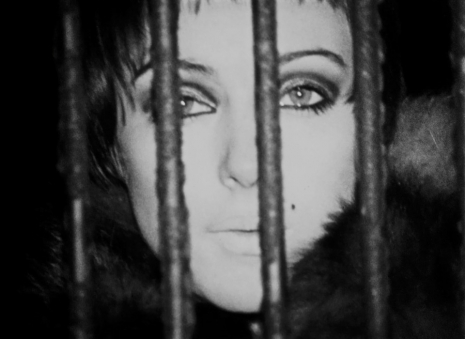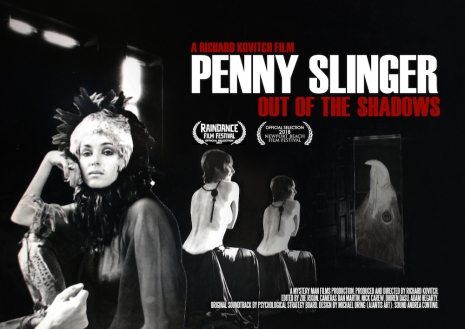
Penny in frame from 16mm film Lilford Hall, 1969, by Penny Slinger and Peter Whitehead
My reaction upon recently being exposed to the work of Penny Slinger, a bold and penetrating surrealist multimedia artist from the U.K. who produced her most striking work in the late 1960s and 1970s, was to suppose that there must have been a mistake of some sort. Slinger’s work, which spans photography, collage, and sculpture, uses techniques of surrealism to address highly pertinent topics of sexuality, gender, and identity in ways that make quite a few people uncomfortable—which is all to her credit, of course. What I could not comprehend, given the stunning clarity, precision, and power of her work, was her relative lack of recognition, a matter that a new documentary by director Richard Kovitch seeks to remedy.
The movie, called Penny Slinger: Out of the Shadows, places the pressing question of the artist’s rediscovery—as well as a major theme of her work—squarely in its title. Born Penelope Slinger in 1947 London to a middle-class family, Slinger attended art school in the mid- to late 1960s, where she was exposed to the work of surrealist Max Ernst, whose art seemed to address many of the questions that Slinger felt most needed addressing. (Later she got to know Ernst.) In 1969, while still a student, she produced a book of ambitious and bracing photocollages, falling into the rubric “feminist surrealism,” under the title 50%—The Visible Woman. In 1971 Slinger became involved with a feminist art collective called Holocaust, which produced a theatrical work in London and at the Edinburgh Festival titled A New Communion for Freaks, Prophets, and Witches—one of Slinger’s primary characters in that production was called simply “The Shadow Man.” This evolved into Jane Arden’s groundbreaking movie, in which Slinger played a major part, entitled The Other Side of the Underneath, which to today’s eyes might come off as something like a feminist Zardoz without being either self-evidently funny or a failure. That movie was marred by a dreadful incident in which the husband of the cellist and composer involved with the movie immolated himself in an obscure attempt at protesting of the movie. Out of the residue of that experience Slinger produced the splendidly focused book of photographic collages based in an abandoned mansion in Northamptonshire, titled An Exorcism. If Slinger had produced nothing but An Exorcism, her career would be well worth celebrating. But there is much, much more.

Poster for Penny Slinger, Penny Slinger: Out of the Shadows (2016), featuring Bird in the Hand, 19.25” x 13.25”, collage from An Exorcism (1977), courtesy Riflemaker Gallery, London. Copyright Penny Slinger.
In 1977, Slinger, following her muse, largely abandoned the world of bracing high art in favor of authorial explorations into Jungian sexual archetypes and the introduction of Tantra into the modern world; works include Sexual Secrets: The Alchemy of Ecstasy, Erotic Sentiment in the Paintings of India and Nepal, and The Pillow Book.
One would have thought that a female artist with work as profoundly arresting as Slinger’s would have become a household name, but in many ways the chameleonic and elusive nature of her work resulted, perversely, in lack of recognition. It could be argued that her work fits in much better with our notions of art today than they did back then, in other words that we’ve caught up to her, rather than the other way around.
As I stated earlier, a new movie about Slinger is on the horizon that has the potential to transform the artist’s currency among the art aficionados (and regular art fans) of our own day. Penny Slinger: Out of the Shadows is still currently playing on the festival circuit in the US and Europe and screened earlier this year at the Tate St. Ives. The movie takes as its subject Slinger’s life and career from her birth up to the late 1970s, after which her visibility as a cutting-edge, provocative artist regrettably diminished. Penny Slinger: Out of the Shadows investigates in detail the themes of Slinger’s work as well as the salient biographical details of her life, which (I assure you) readers of Dangerous Minds are well-nigh guaranteed to find of great interest. We get to see a great deal of Slinger’s work, which (as already stated) has a knack for holding viewers’ attention. Slinger herself is on hand for interviews in which she clarifies how things looked from her perspective, as are several of her key collaborators as well as a handful of commentators from the art world or academia to supply valuable context.
Kovitch has told me that he is hopeful that a DVD/VOD distribution deal will solidify in the near future. Speaking personally, I cannot wait for this movie to find a broader viewership because it does such an outstanding job of placing Slinger’s career in context and teasing out the manifold ways in which her work speaks to us in the second decade of the 21st century. For anyone tracking the intersection of surrealism and gender, it’s an essential work.
An interview with Penny Slinger, after the jump…





